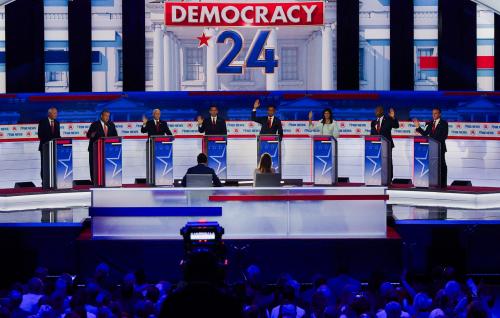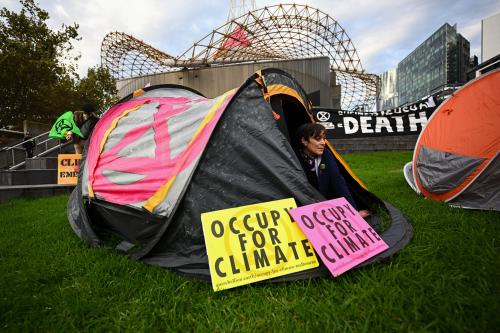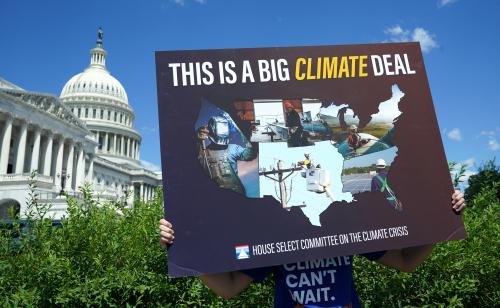A divisive energy policy debate is playing an increasingly prominent role in the presidential election campaign, reflecting long-simmering themes that emerged in the 1970s.
The first theme is the challenge of balancing three, often competing components of energy policy. There is a national security goal – reducing vulnerability to supply disruptions and price shocks linked to our overwhelming use of oil in transportation and dependence on oil imports. There are environmental goals – reducing pollution and adverse health effects of energy use, as well as meeting the challenge of global climate change, namely reducing CO2 emissions from burning fossil fuels. And finally there are broader economic goals embedded in energy policy – keeping prices low to bolster economic growth, creating jobs, promoting new industries or technologies, and raising revenue.
Balancing and prioritizing these goals is notoriously difficult. For example, our abundant natural gas supplies are frequently touted as providing major economic benefits, but there are also environmental concerns. Moreover, goals change over time; in the 1970s we instituted policies to shift oil out of electricity generation and promoted coal use for national security and economic reasons, while now we are looking for ways to reduce coal use for environmental reasons.
The second major theme is the roiling debate over the role of government. While not limited to the energy sector, there are nearly constant heated discussions over fundamental questions: What is the right way – if any – for the government to influence or participate in the market? What is the right mix of policy approaches, i.e., market-based vs. command and control? In the last several years we have heard much criticism about the dangers (market distortions, waste of taxpayers’ money) of government “picking winners” in fuels, technologies, or sectors. And there is growing support for government to promote a “portfolio” approach; that our challenges are so complex that – as one utility CEO phrased it – we need “silver buckshot” not a “silver bullet”. In today’s policy discourse this is called an “all of the above” approach.
The third theme is the tension over supply-side and demand-side policy approaches. After the 1970s, there was an increased focus on alternatives to fossil fuels, and on the demand side (efficiency and conservation). To this day we see a tug-of-war over how to prioritize and balance different supply-side solutions, as well as how to balance supply options vs. demand side options.
In the current political arena, a renaissance in domestic oil and gas production spurred by horizontal drilling and hydraulic fracturing and the recent economic downturn, have framed energy policy issues largely around economic themes, placed a focus on domestic supply solutions, and intensified the debate over role of government.
The focus on stimulating economic growth and creating jobs has shifted emphasis away from environmental objectives; and any discussion about addressing global climate change as a major policy goal has all but disappeared. Indeed, neither Obama nor Romney’s campaign websites mention “climate change.” The appropriate role of government also is a major theme, perhaps most evident in whether or how the government should support clean energy technology. The era of rising deficits and shrinking budgets is increasing pressure to reduce government programs; for example see the debate surrounding extension of the production tax credit for wind, and the loan guarantee program. Supply-demand tensions are also a central part of the debate, with many calling for government to get out of the way and allow the development of abundant fossil resources to achieve our economic objectives and enhance national security. Supporters of the Keystone XL pipeline, opening up more onshore and offshore hydrocarbons for exploration, and rolling back EPA regulations on coal-fired power generation are illustrative of this theme.
Does this leave us in inexorable deadlock, doomed to repeat the same bleak battles since the 1970s? Not necessarily. Clearly the rhetoric of an election campaign leaves little room for nuance, and energy is all about nuance. But our research discussions with a wide array of stakeholders indicate a glimmer of common ground. Specifically, there are nascent signs of agreement on basic principles: energy policy should be technology neutral, promote price transparency, and leverage private sector investment.
First, it is certainly true that no specific, comprehensive federal energy-climate policy is in place, and an overarching policy with carbon pricing is unlikely in the near-term – the stigma of higher energy prices in this economy in an election year is a non-starter. But feedback we received from a cross-section of the federal government, state governments, developers, regulators, venture capitalists, and utilities reveal a shared view that federal leadership is very important. The markets want business certainty – this is the best way to stimulate the economy. In the words of one utility executive a federal policy framework would “let utilities or third parties figure out the least-cost path to carbon reduction.”
In this regard, a carbon tax is getting more attention as a means to help address the fiscal situation as well as our energy goals (but probably not as stand-alone energy policy). We’re hearing more support for this policy tool from conservatives. For example, Former Sec. of State George Schulz recently voiced support for a revenue neutral carbon tax stating that it “could bring together the constituencies concerned with national security, the economy and the environment — both local and global — that would be a potent coalition.”
Second, in terms of clean energy technology policy, participants in our research called for “policy survivability,” and “consistency of purpose and vision.” One cogeneration developer told us “The technologies are there but the game is so impossible to understand. Our clients are planning at 3-5 year business cycles, but tax credits, rebates etc., are changing every couple of years… we need certainty over 10 years.” We heard a widespread view that financial mechanisms needed to be “smarter,” especially in the current atmosphere of spending cuts and calls for a reduced role for government. Smarter means tailoring financial incentives to better address the stages of technology innovation and to be phased out over time as a technology becomes more commercially deployed. My Brookings colleague Mark Muro has also recently cited that an alternative approach in which subsidies and incentives have a more predictable path toward innovation, cost reduction and phase out is gaining traction on both sides of the aisle.
These are just a few of the promising signs if we look beyond the election season and seize the common ground in energy policy. It’s the only way to break away from our decades-old, repetition of arguments that get us nowhere.



Commentary
Op-edCommon Ground in Energy Policy
August 14, 2012